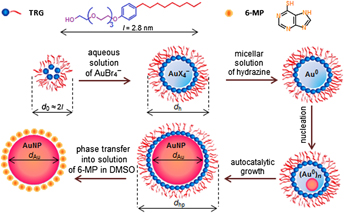Crossref Citations
This article has been cited by the following publications. This list is generated based on data provided by
Crossref.
Tatarchuk, V. V.
Dobrolyubova, Yu. O.
Druzhinina, I. A.
Zaikovskii, V. I.
Gevko, P. N.
Maksimovskii, E. A.
and
Gromilov, S. A.
2016.
Facile synthesis of gold nanoparticles in aqueous acrylamide solution.
Russian Journal of Inorganic Chemistry,
Vol. 61,
Issue. 4,
p.
535.
Tatarchuk, V. V.
Druzhinina, I. A.
Zaikovskii, V. I.
Maksimovskii, E. A.
Gromilov, S. A.
Gevko, P. N.
and
Petrova, N. I.
2017.
Synthesis of gold nanoparticles and thin films with the use of micellar solution of Brij 30.
Russian Journal of Inorganic Chemistry,
Vol. 62,
Issue. 3,
p.
372.
Kolodin, Aleksei N.
Tatarchuk, Vladimir V.
Bulavchenko, Alexander I.
and
Poleeva, Evgeniia V.
2017.
Synthesis and Electrophoretic Concentration of Cadmium Sulfide Nanoparticles in Reverse Microemulsions of Tergitol NP-4 in n-Decane.
Langmuir,
Vol. 33,
Issue. 33,
p.
8147.
Watzky, Murielle A.
and
Finke, Richard G.
2018.
Gold Nanoparticle Formation Kinetics and Mechanism: A Critical Analysis of the “Redox Crystallization” Mechanism.
ACS Omega,
Vol. 3,
Issue. 2,
p.
1555.
Mahto, Madhusudan Kr.
Samanta, Dipanjan
Konar, Suraj
Kalita, Himani
and
Pathak, Amita
2018.
N, S doped carbon dots—Plasmonic Au nanocomposites for visible-light photocatalytic reduction of nitroaromatics.
Journal of Materials Research,
Vol. 33,
Issue. 23,
p.
3906.
Sandoe, Haley E.
Watzky, Murielle A.
and
Diaz, Steven A.
2019.
Experimental probes of silver metal nanoparticle formation kinetics: Comparing indirect versus more direct methods.
International Journal of Chemical Kinetics,
Vol. 51,
Issue. 11,
p.
861.
Lone, Irfan Hussain
Radwan, Nagi R.E.
Aslam, Jeenat
and
Akhter, Arifa
2019.
Concept of Reverse Micelle Method For the Synthesis of Nano-Structured Materials.
Current Nanoscience,
Vol. 15,
Issue. 2,
p.
129.
Yaraki, Mohammad Tavakkoli
and
Tan, Yen Nee
2020.
Metal Nanoparticles‐Enhanced Biosensors: Synthesis, Design and Applications in Fluorescence Enhancement and Surface‐enhanced Raman Scattering.
Chemistry – An Asian Journal,
Vol. 15,
Issue. 20,
p.
3180.
Yazdani, Sima
Junor, Glen P.
Peltier, Jesse L.
Gembicky, Milan
Jazzar, Rodolphe
Grotjahn, Douglas B.
and
Bertrand, Guy
2020.
Influence of Carbene and Phosphine Ligands on the Catalytic Activity of Gold Complexes in the Hydroamination and Hydrohydrazination of Alkynes.
ACS Catalysis,
Vol. 10,
Issue. 9,
p.
5190.
Kirner, Felizitas
Potapov, Pavel
Schultz, Johannes
Geppert, Jessica
Müller, Magdalena
González-Rubio, Guillermo
Sturm, Sebastian
Lubk, Axel
and
Sturm, Elena
2020.
Additive-controlled synthesis of monodisperse single crystalline gold nanoparticles: interplay of shape and surface plasmon resonance.
Journal of Materials Chemistry C,
Vol. 8,
Issue. 31,
p.
10844.
Kolodin, A. N.
Korostova, I. V.
Maksimovskiy, E. A.
Arymbaeva, A. T.
and
Bulavchenko, A. I.
2020.
The Study of the Dispersity of Gold Aerosols with the Use of Au–AOT Composite Films.
Colloid Journal,
Vol. 82,
Issue. 5,
p.
529.
Mota, Danielle Ramos
Lima, Giovanni Alexsander Silva
Helene, Gustavo Boniatti
and
Pellosi, Diogo Silva
2020.
Tailoring Nanoparticle Morphology to Match Application: Growth under Low-Intensity Polychromatic Light Irradiation Governs the Morphology and Optical Properties of Silver Nanoparticles.
ACS Applied Nano Materials,
Vol. 3,
Issue. 5,
p.
4893.
Whitehead, Christopher B.
and
Finke, Richard G.
2021.
Particle formation mechanisms supported by in situ synchrotron XAFS and SAXS studies: a review of metal, metal-oxide, semiconductor and selected other nanoparticle formation reactions.
Materials Advances,
Vol. 2,
Issue. 20,
p.
6532.
Sergievskaya, Anastasiya
O’Reilly, Amy
Alem, Halima
De Winter, Julien
Cornil, David
Cornil, Jérôme
and
Konstantinidis, Stephanos
2021.
Insights on the Formation of Nanoparticles Prepared by Magnetron Sputtering Onto Liquids: Gold Sputtered Onto Castor Oil as a Case Study.
Frontiers in Nanotechnology,
Vol. 3,
Issue. ,
Mironov, Igor V.
and
Kharlamova, Viktoria Yu.
2021.
Synthesis of gold nanoparticles in aqueous solutions not containing additional interfering components using sulfite method: the effect of thiol-containing acid additives.
Gold Bulletin,
Vol. 54,
Issue. 1,
p.
37.
Whitehead, Christopher B.
Özkar, Saim
and
Finke, Richard G.
2021.
LaMer's 1950 model of particle formation: a review and critical analysis of its classical nucleation and fluctuation theory basis, of competing models and mechanisms for phase-changes and particle formation, and then of its application to silver halide, semiconductor, metal, and metal-oxide nanoparticles.
Materials Advances,
Vol. 2,
Issue. 1,
p.
186.
Kolodin, Aleksei Nikitich
2022.
Hydrophilization and plasmonization of polystyrene substrate with Au nanoparticle organosol.
Surfaces and Interfaces,
Vol. 34,
Issue. ,
p.
102327.
Sergievskaya, Anastasiya
Chauvin, Adrien
and
Konstantinidis, Stephanos
2022.
Sputtering onto liquids: a critical review.
Beilstein Journal of Nanotechnology,
Vol. 13,
Issue. ,
p.
10.
Anik, Muzahidul I.
Mahmud, Niaz
Al Masud, Abdullah
and
Hasan, Maruf
2022.
Gold nanoparticles (GNPs) in biomedical and clinical applications: A review.
Nano Select,
Vol. 3,
Issue. 4,
p.
792.
Sergievskaya, Anastasiya
Absil, Rémi
Chauvin, Adrien
Yusenko, Kirill V.
Veselý, Jozef
Godfroid, Thomas
and
Konstantinidis, Stephanos
2023.
Sputtering onto liquids: how does the liquid viscosity affect the formation of nanoparticles and metal films?.
Physical Chemistry Chemical Physics,
Vol. 25,
Issue. 4,
p.
2803.
